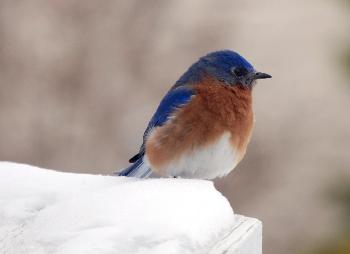|
|
|
Enjoying Wild Birds in the Lower 48
A Weekly Column from The Birdlady®
|
Bluebirds Are Now Checking The Housing Market
"The bluebird of happiness"-it's a cliche, and like all cliches, it got that way by (The only exception I can think of is my next-door neighbor, who's annoyed every year by an obstreperous Eastern bluebird who attacks his reflection in the side mirrors of her car, leaving occasional droppings to mar the finish. I suggested she mask the mirrors by slipping oven mitts over them-then she can relax and enjoy the bluebird's color and his chortling melodies.) Audubon magazine found out by accident some years ago just how excited people get over bluebirds. When the magazine omitted an essential detail from the Warren Lauder bluebird nest box design featured in its January-February 1999 issue, the editors got a landslide of questions from readers eager to build the box. The editors were amazed, but I was not. For decades as a newspaper bird columnist in Delaware and Pennsylvania, I'd been offering Lauder's plan free in return for a stamped self-addressed envelope. Warren and his wife Dot patiently stuffed and returned the SASEs, and he estimated after the first 10 years that they'd sent out more than 5,000. You can download the plan right here, no charge, no SASE-but first let me tell you a little about it. Eastern bluebirds were in big trouble in 1961 when Lauder first got interested-it took three years for him just to find one near his home in Chester County, Pa. The gorgeous little thrushes were suffering from a lethal combination of pesticides, habitat destruction, a siege of severe ice storms in the late 1950s and competition for the few remaining nest sites from alien starlings and house sparrows. Yet in that same area on the 2007-08 West Chester Bird Club Christmas Count (the most recent one available), 231 Eastern bluebirds were counted-in winter, when many bluebirds have left the area to fly south. Much of the increase is due to the dedication of Lauder, who has spent nearly five decades tending hundreds of bluebird houses and persuading other people to erect thousands more. Now 87 and living in a retirement community, he's still dedicated to bluebirds, developing yet another trail of nest boxes. Every detail of the Lauder nest box has been refined to keep large families of bluebirds safe, dry and comfortable. Here are some salient points:
Across the U.S., with days lengthening and weather beginning to warm, February is the ideal time to put out bluebird nest boxes if you want to attract bluebirds for their first nesting of the season. For a copy of Lauder's nest-box plan, CLICK HERE (PAGE 1) and HERE (PAGE 2); included are suggestions for locating the box where bluebirds are most likely to use it. (Chickadees and titmice may use it instead, if the box is placed near woods-in my opinion that's a happy outcome, to be celebrated by building another box to offer the bluebirds in a more open location!) In coming weeks, I'll tell you about adapting the Lauder plan to suit other birds and also what to do about house wrens and house sparrows that may compete with the bluebirds for use of your new nest box. © 2009 Frances Hamilton. The Birdlady® is a lifelong journalist who has written weekly columns about wild birds since 1968. |
|
If you would like to have the Birdlady's column e-mailed
to you each week, enter your e-mail address below. Your information will be kept private and not given or sold
to any third party.
|
 being true. Whether a bluebird is the Eastern, Western or mountain variety, it's loved by almost everybody.
being true. Whether a bluebird is the Eastern, Western or mountain variety, it's loved by almost everybody.